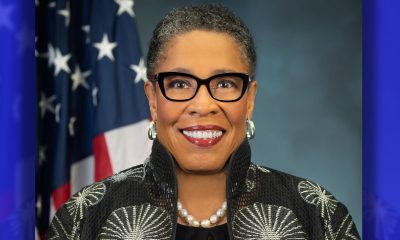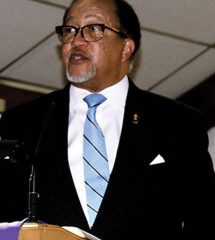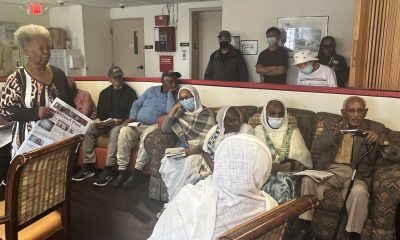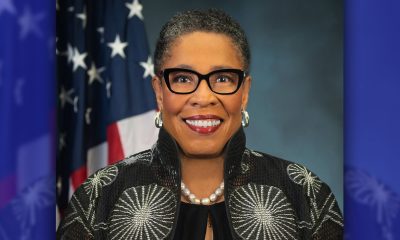Technology
HUD Chief Seeks Broadband Access for the Poor

Julián Castro, the secretary of the Department of Housing and Urban Development talks about the importance of homeownership in the African American community. (Freddie Allen/NNPA Photo)
By Freddie Allen
NNPA Senior Washington Correspondent
WASHINGTON (NNPA) – Julián Castro, the secretary of the Department of Housing and Urban Development, wants to provide broadband access to public housing residents in an effort to increase socioeconomic mobility among poor and low-income families.
“We think [broadband access] is important because the world requires a connection to the Internet now,” said Castro.
He said that HUD wants to launch the program, which is still in its early planning stages, in 20 major metropolitan areas working with private sector telecommunication companies to wire the communities or provide wireless in a free or very low-cost way.
Castro said that in the vast majority of public housing communities, there is no connectivity.
According to a 2014 report by the Pew Research Center, most households with incomes below $20,000, “do not have an internet subscription for a computer, cell phone or other device, though they may have free access at a local library or elsewhere.” Roughly 25 million American households, “have no regular internet access at all, either at home or elsewhere.”
Sixty-two percent of Black adults have broadband access at home compared to 74 percent of White adults. A gap of 12 percent. The digital divide between Black and White adults 65 and older leaps to 21 percent (30 percent vs. 51 percent who have broadband at home).
A 2010 Pew survey revealed that Americans feel that people that don’t have broadband access at home “are at a major disadvantage when it comes to finding out about job opportunities or learning career skills, or when getting health information, learning new things for personal enrichment, and using government services.”
Castro said that a respectable number of people have Internet connection through their cell phone, but it’s not the same as having that access in your home where it’s more stable and you can do homework and other things that people generally don’t do on their phones.
Castro attended junior high school with a lot of kids that lived in public housing and his father also lived in public housing at different periods in his life.
“I know that the folks who live in public housing have the same aspirations and the same potential as anybody else,” said Castro. “And here at HUD we’re going to do every single thing that we can to make sure that they can be a part of our American success story.”
That American success story includes increasing homeownership to build wealth from one generation to the next and to increase upward mobility, and that’s a part of HUD’s long-term mission.
The department’s most immediate challenge, however, is addressing disparities in the rental market.
Blacks not only face discrimination in the rental market, but they also are treated differently than Whites when they look to become homeowners.
According to a 2013 report by the Department of Housing and Urban Development, “Black renters who contact agents about recently advertised housing units learn about 11.4 percent fewer available units than equally qualified whites and are shown 4.2 percent fewer units.”
Blacks are also offered shorter leases and told that background checks are required more often than White renters.
Blacks faced even greater discrimination when attempting to buy a home. When Blacks contacted agents about recently advertised homes they were shown roughly 18 percent fewer homes than White homebuyers. During the housing crisis, minorities were often offered subprime loans products, even when they qualified for better loan conditions.
“Too many times African American families don’t get the same opportunities to evaluate potential homes or rental properties just because of the color of their skin and we want to root that out,” said Castro.
The United States Census Bureau reported that the homeownership rate for Blacks was 42.1 percent in the fourth quarter of 2014, the lowest of all racial groups. Whites had the highest homeownership rate at 72.3 percent. The homeownership rates for both groups were down from the same period in 2013.
Castro said that the bulk of wealth of African Americans and Latinos is tied up in their homes.
Biniam Gebre, the acting commissioner for the Federal Housing Administration (FHA), said that even though homeownership rates have fallen, people are still creating families and having babies and that’s creating pressure on the rental market which, in turn, is causing the rise in rental costs.
“The rental market and the homeownership market are inextricably linked,” said Gebre. “You have to deal with both problems you just can’t deal with one.”
In an effort to make homeownership more affordable, Castro said that the administration is working to reduce mortgage insurance premiums, a fee that skyrocketed 145 percent ($1,600 more annually), since the housing crisis began in 2007.
“That has a significant negative impact on the ability of folks with modest means in particular communities of color to be able to afford to buy a home,” said Castro.
Castro said that reducing the premium would allow 250,000 more borrowers to afford a home through the FHA and the average borrower will save about $900 every year.
“The [Federal Housing Administration] FHA continues to play a vital role in creating a ticket to middle class and wealth creation through homeownership,” said Castro.
Castro said that HUD has also made significant investments in presale counseling, homeowner counseling, and financial literacy to help homebuyers understand the real cost of homeownership.
That real cost was a burden that many homeowners in Prince George’s County were ill-prepared for when the housing bubble burst.
Two years after the recession officially ended, more than 50 percent of housing sales in Prince George’s County, known as the wealthiest majority Black county in the nation, were in foreclosure properties, according to Metropolitan Regional Information Systems (MRIS), a multiple listing service for real estate professionals. Bankrate.com, an online aggregator of financial rate information said that Maryland was second in the nation for housing units receiving foreclosure filings in December 2014.
Through a national mortgage settlement agreement, Maryland’s former Attorney General Doug Gansler secured $10 million in aid for Prince George’s County homeowners and residents seeking affordable housing.
The distressed assets sale program (DASP), launched in 2012 also encouraged lenders to work with borrowers to avoid foreclosure and help residents stay in their homes.
Gebre said that for places like Prince George’s County where neighborhoods are plagued by high foreclosure rates and many homeowners are underwater on their loans, “the Home Affordable Modification Program (HAMP) can provide significant reduction in the debt that they owe.”
Through HUD’s streamlined refinancing program, Gebre added that borrowers who are not in delinquency can benefit from lower rates in the marketplace without having to do a lot of paperwork.
Castro said that it’s the combination of providing housing and providing the opportunity that excited him the most about his role as secretary of HUD, a post he’s held since July 2014. The San Antonio, Texas native said that the investments that are made across HUD make a difference in creating more opportunity for all Americans and those opportunities are particularly significant in the African American community.
“We can’t truly have a nation of opportunity until everyone, no matter their background or the color of their skin, has the chance to fully enjoy the same opportunity,” said Castro. “And we’re not there yet.”
###
Antonio Ray Harvey
Feds: California Will Be Home to New National Semiconductor Technology Center
California was chosen by the U.S. Department of Commerce (Commerce) and Natcast, the operator of the National Semiconductor Technology Center (NSTC) to be home to the headquarters for the National Semiconductor Technology Center – as part of the Biden-Harris Admin’s CHIPS and Science Act. The CHIPS for America Design and Collaboration Facility (DCF) will be one of three CHIPS for America research and design (R&D) facilities and will also operate as the headquarters for the NTSC and Natcast.

By Antonio Ray Harvey
California was chosen by the U.S. Department of Commerce (Commerce) and Natcast, the operator of the National Semiconductor Technology Center (NSTC) to be home to the headquarters for the National Semiconductor Technology Center – as part of the Biden-Harris Admin’s CHIPS and Science Act.
The CHIPS for America Design and Collaboration Facility (DCF) will be one of three CHIPS for America research and design (R&D) facilities and will also operate as the headquarters for the NTSC and Natcast.
“We are thrilled that the Department of Commerce and Natcast chose to locate this critically important facility in Sunnyvale, the heart of the Silicon Valley, alongside the world’s largest concentration of semiconductor businesses, talent, intellectual property, and investment activity,” said Dee Dee Myers, Senior Economic Advisor to Gov. Gavin Newsom and Director of the Governor’s Office of Business and Economic Development (GO-Biz). “The Newsom Administration and our partners across the industry know how important it is to shorten the timeframe from R&D to commercialization.”
According to GO-Biz, the DCF is expected to direct over $1 billion in research funding and create more than 200 employees in the next decade. The facility will serve as the center for advanced semiconductor research in chip design, electronic design automation, chip and system architecture, and hardware security. The CHF will be essential to the country’s semiconductor workforce development efforts.
As detailed in the released NSTC Strategic Plan, the DCF will suppress the obstacles to “semiconductor prototyping, experimentation,” and other R&D activities that will enhance the country’s global power and leadership in design, materials, and process innovation while enabling a vigorous domestic industr“Establishing the NSTC headquarters and design hub in California will capitalize on our state’s unparalleled assets to grow a highly skilled workforce and develop next-generation advancements,” stated U.S. Sen. Alex Padilla (D-Calif.). “This CHIPS Act funding will propel emerging technologies and protect America’s global semiconductor leadership, all while bringing good-paying jobs to our state.”
Community
Advanced Conductors Provide Path for Grid Expansion
Utility companies in the United States could double electric transmission capacity by 2035 by replacing existing transmission lines with those made from advanced materials, according to a new study published Monday in the Proceedings of the National Academy of Sciences.

By Matthew Burciaga
UC Berkeley News
Utility companies in the United States could double electric transmission capacity by 2035 by replacing existing transmission lines with those made from advanced materials, according to a new study published Monday in the Proceedings of the National Academy of Sciences.
Led by Duncan Callaway, professor and chair of the Energy and Resources Group (ERG), and Amol Phadke, an affiliate and senior scientist at the Goldman School of Public Policy, the first-of-its-kind study details a faster and more cost-effective way to expand the grid and connect the more than 1,200 gigawatts of renewable energy projects awaiting approval. The analysis was first published last December as a working paper by the Energy Institute at Haas and has been covered by the New York Times, the Washington Post, Heatmap News, and other news outlets.
“Expanding transmission capacity is critical to decarbonization, and we sought to study ways to build it faster and cheaper,” said Callaway.
It currently takes 10 to 15 years to build a new power line and the U.S. is building transmission lines at a lower rate than it was in the past decade. Without sufficient capacity, renewable energy projects often sit in limbo for years as transmission operators study what upgrades—if any—are needed to accommodate the increased loads.
The authors modeled various scenarios to determine if replacing existing transmission conductors with those made with advanced composite-core materials—a process known as reconductoring—could provide a pathway to faster grid expansion.
Several reconductoring projects have been initiated in Belgium and the Netherlands, and utility companies in the U.S. have used the material to string transmission lines across wide spans like river crossings. That technology, however, has not made its way to the majority of overhead power lines that feed residential and commercial customers.
“As we learned more about the technology, we realized that no one had done the detailed modeling needed to understand the technology’s potential for large-scale transmission capacity increases,” said Phadke.
Based on the authors’ projections, it is cheaper—and quicker—for utility companies to replace the 53,000 existing transmission lines with advanced composite-core materials than it is to build entirely new transmission lines.
They assert that doing so would reduce wholesale electricity costs by 3% to 4% on average—translating to $85 billion in system cost savings by 2035 and $180 billion by 2050.
“The level of interest we’ve received from federal and state agencies, transmission companies and utilities is extremely encouraging, and since our initial report, the Department of Energy has committed hundreds of millions of dollars to reconductoring projects,” said co-author Emilia Chojkiewicz, a PhD student in ERG and an affiliate of the Goldman School of Public Policy. “We are looking forward to learning about these projects as they unfold.”
Additional co-authors include Nikit Abhyankar and Umed Paliwal, affiliates at the Goldman School of Public Policy; and Casey Baker and Ric O’Connell of GridLab, a nonprofit that provides comprehensive technical grid expertise to policy makers and advocates.
Black History
A Life of Inventions: Engineer and Physicist George Alcorn
George Edward Alcorn Jr. was born on March 22, 1940, in Indianapolis. Growing up in a family that valued education, Alcorn developed an early love for science and mathematics. He excelled in school, and attended Occidental College in California, where he earned a bachelor’s degree in physics in 1962. He received a master’s degree in nuclear physics in 1963 and a Ph.D. in atomic and molecular physics in 1967 at Howard University.

By Tamara Shiloh
George Edward Alcorn Jr. was born on March 22, 1940, in Indianapolis.
Growing up in a family that valued education, Alcorn developed an early love for science and mathematics. He excelled in school, and attended Occidental College in California, where he earned a bachelor’s degree in physics in 1962. He received a master’s degree in nuclear physics in 1963 and a Ph.D. in atomic and molecular physics in 1967 at Howard University.
Alcorn began his career in developing scientific technology in private industries, starting a career as a physicist for IBM. His career took off when he joined several prestigious companies and research institutions, such as the Aerospace Corporation, where he developed important technologies for spacecraft. In 1978, he accepted a position at NASA’s Goddard Space Flight Center, where he worked for the remainder of his career. There, he developed technologies for space stations and private institutions across the nation, becoming a key figure in the field of physics and space exploration.
Alcorn is well known for his groundbreaking work on X-ray spectrometers. An X-ray spectrometer is a device used to identify different elements in materials by analyzing the X-ray wavelengths they emit. His improvements allowed the instrument to detect X-rays with greater accuracy and efficiency. This invention has been critical for NASA’s space missions, aiding in the analysis of planetary atmospheres and surfaces, including Mars and other planets in our solar system.
He also contributed to the development of plasma etching, a process used in manufacturing microchips for computers and electronics. His work in this area advanced semiconductor technology, which powers everything from smartphones to satellites.
Another accomplishment was the development of new technologies used in the Freedom space station in partnership with space agencies in Japan, Canada and Europe, though their projects never made it to space.
Throughout his career, Alcorn received several awards and honors, including NASA’s Inventor of the Year Award in 1984. In 2010, he received the highest honor from NASA’s Goddard Space Flight Center. In 2015, Alcorn was inducted into the National Inventors Hall of Fame for his invention of the imaging X-ray spectrometer.
In addition to his work in the lab, Alcorn dedicated much of his time to teaching and mentoring young scientists. As one of the few African American scientists working in advanced fields like physics and space exploration, he has been an inspiration to young people, especially those from underrepresented groups in STEM (science, technology, engineering, and mathematics). He taught at Howard University and worked to encourage more African Americans to pursue careers in science and engineering.
George is quoted as stating, “The big thing about being in science and engineering is that if you have a good, interesting project going, work is not coming to work, it’s coming to an adventure.”
George Edward Alcorn passed away June 19, 2024.
-

 Alameda County4 weeks ago
Alameda County4 weeks agoAlameda County District Attorney Pamela Price Announces $7.5 Million Settlement Agreement with Walmart
-

 Activism3 weeks ago
Activism3 weeks ago‘Jim Crow Was and Remains Real in Alameda County (and) It Is What We Are Challenging and Trying to Fix Every Day,’ Says D.A. Pamela Price
-

 Bay Area4 weeks ago
Bay Area4 weeks agoIn the City Attorney Race, Ryan Richardson Is Better for Oakland
-

 Activism3 weeks ago
Activism3 weeks agoOakland Post: Week of October 30 – November 5, 2024
-

 Alameda County3 weeks ago
Alameda County3 weeks agoD.A. Price Charges Coliseum Flea Market Vendors in Organized Retail Theft Case
-

 Activism3 weeks ago
Activism3 weeks ago‘Criminal Justice Reform Is the Signature Civil Rights Issue of Our Time,’ says D.A. Pamela Price
-

 Activism2 weeks ago
Activism2 weeks agoLIVE! — TOWN HALL ON RACISM AND ITS IMPACT — THURS. 11.14.24 5PM PST
-

 Activism4 weeks ago
Activism4 weeks ago“Two things can be true at once.” An Afro-Latina Voter Weighs in on Identity and Politics























































